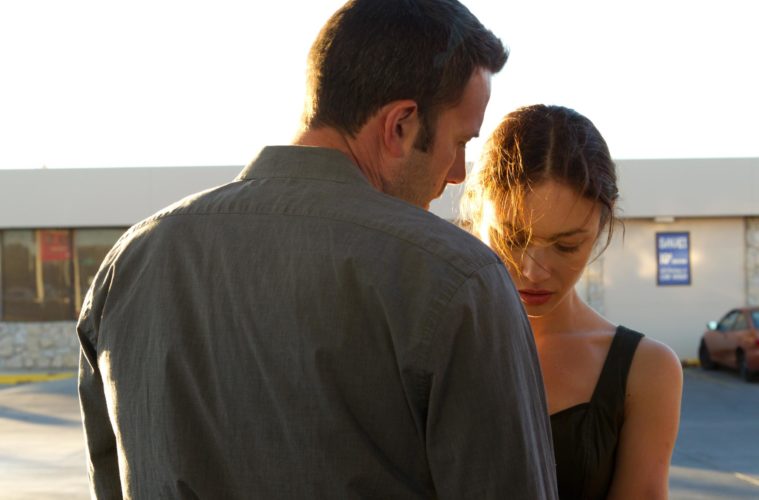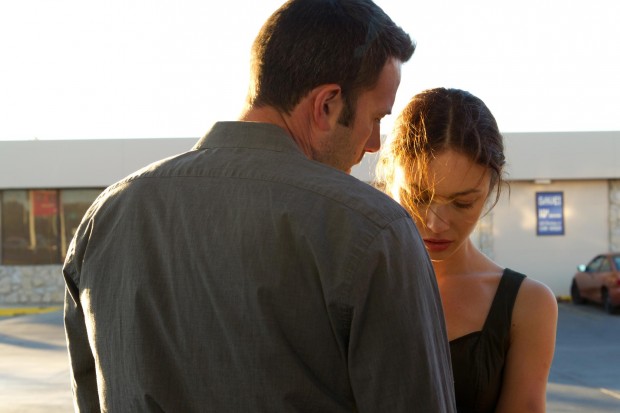
Although it may not be considered as such to many viewers, the return of Terrence Malick to cinemas is about as substantial as any “event film” one can witness around these parts. After a full-fledged review of his latest work, To the Wonder, following its Toronto International Film Festival premiere last fall, the film is finally coming to U.S. theaters this week. For the occasion, we recently explored how Malick’s previous films influenced his most recent and now it’s time to examine his latest work itself.
Considering its divisive reception, we thought the best way to provide an in-depth dissection of To the Wonder is by doing so from three different angles. Below one will find a three-way discussion between our editor-in-chief Jordan Raup, associate editor Nick Newman and staff writer Danny King. Written over the course of nearly a month, check it out below and let us know if you fall on the side of misunderstood masterpiece, his first flop or anywhere in between.
Jordan R.: As readers of this site may know, I’m a fervent Terrence Malick fan and consider his films among my favorites. Heading into To the Wonder, I knew of its divisive reception last fall so I tempered my expectations, even though the rest of his work has had a similar initial response. My first impression is that it’s Malick’s least successful film, but there is still much to admire in this romantic drama. After experimenting with the idea of cinema as a memory — most substantially in the middle portion of The Tree of Life — this entire film takes this approach and it’s one I greatly appreciated. Ben Affleck‘s character takes a sometimes painful emotional journey, and as a negative, there are times when I felt like a detached observer, rather than connected with what was in front of me.
Danny K.: As an equally ardent fan of Terrence Malick’s cinema — I consider each of his first five features to be full-stop masterpieces — I, too, was eager to see how he would follow up The Tree of Life, which has a scale of ambition, both personally (it’s very autobiographical) and cosmically (it shows the creation of the universe in painstaking detail), that seems almost impossible to match. After sitting on To the Wonder for about a week now, I have to agree with you, at least at the moment, that this is his “least successful work.” At the same time, though, the film is clearly, for me, the first step in a new direction for Malick, so I’m not sure how valuable it is to judge it solely within the context of his earlier works. Much has been made of Malick’s recent amped-up productivity: right now, he has something like three other projects in post-production, which marks an obvious departure from the lengthy time periods that separated his first five films. Additionally, To the Wonder is Malick’s first fully contemporary film, another sign that supports the idea of To the Wonder as a stepping stone into a fresh career path for the auteur.
Aesthetically and tonally, however, the film feels of a piece with Malick’s body of work. Most of the characters — with Olga Kurylenko’s Marina perhaps emerging as the film’s main character — are given Malick’s customary voice-over treatment, the words of which are vague and wispy enough to sufficiently enrage Malick dissenters. There’s also the presence of Javier Bardem’s Father Quintana: though really kind of a tangential figure in the film, Quintana nevertheless informs the film with typical Malick themes of faith and religion. Finally, after the likes of The New World and The Tree of Life, To the Wonder marks Malick’s third collaboration with cinematographer Emmanuel Lubezki, and, as long as this partnership continues, nothing Malick makes in the future will be without some merit. Lubezki’s camera, which floats through space as if observing these locations for the very first time, gives rise to images of predictably breathtaking beauty, though it’s maybe his more haunting compositions that sting most: the film’s unsettlingly cold and distant depiction of American suburbia is among its most powerful qualities.
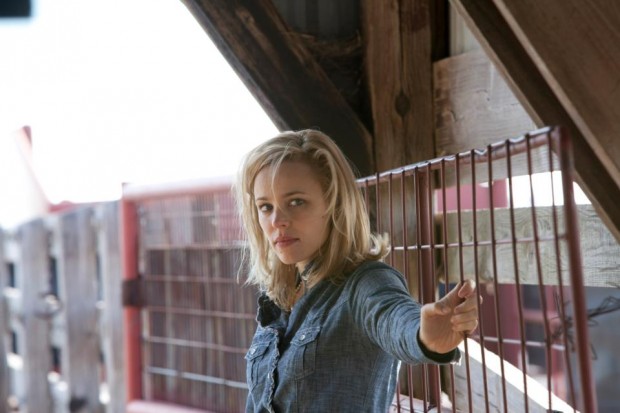
Nick N.: When I was on my way home after To the Wonder, the first person I had a phone conversation with asked — simply, but, in this case, more forthright than they could possibly understand — “How was it?” After stumbling over my “uhhs” and “wells” for roughly five seconds (the struggle of which was only compounded by mild tittering on the other line), the most concise reaction I could surmise was, “It’s not without interest.”
This writing marks one week since our viewing, and in the time since I’ve continued to struggle with any one- or two-sentence reaction. But it doesn’t get much better when thoughts are expanded outward: the more frequently Terrence Malick’s dance of love plays in my mind, the more obstinately it feels like an awkwardly assembled, strangely (and unbelievably) cold selection of B-roll footage cut from a better movie. (That this is coming from someone who will fully defend every single piece in The Tree of Life as germane might, perchance, give that criticism some more weight.) To the Wonder is not this man’s worst piece of work — I’ve never been able to jibe with what feels to be an uncomfortable meld of philosophy and brutishness that characterizes The Thin Red Line, after all — but even if this doesn’t mark a nadir, it also feels like the first disposable entry in his oeuvre. And, if this marks what Danny assumes — i.e., a sort of stepping stone — the next direction of his career already leaves me somewhat concerned.
Jordan R.: I wouldn’t use the word “disposable,” but this is certainly his coldest film, which is perhaps troubling to some considering his sole mission here is to capture love in many forms. But I did find it remarkable how Malick can effectively convey the ups and downs in Affleck’s relationship over an extensive period with only a handful of spoken lines. What didn’t gel as smoothly was Javier Bardem’s arc. It’s somewhat apparent that Malick had greater intentions for his story, but his priest character felt slightly tacked on and, while I liked individual scenes, whenever the film switched gears, it started to drag.
Nick N.: In a picture that contains several troubling digressions, those featuring Father Quintana (one of only two character names I can so much as remember) stand as perhaps the most suspicious. Jumping to and fro these moments as Wonder’s main narrative played out, it was rather easy to make connections with his personal struggle, even as I was thinking that an entire 110 minutes with him would make for a truly great film. But dropped amidst a different story we’ve been following from the beginning, the immense beauty of these sequences, visually and thematically, are all that can deflect a touch of irrelevancy.
Maybe going to that length is unfair; it’s better to argue that we have pieces meant to form a whole which Malick, unfortunately, never snaps in their proper place. Granted, their sense of thematic consistency (not to mention the feeling it inspired in myself) is not unlike the Sean Penn / cosmos / beach material in The Tree of Life, though the key to what Malick got right, there, is knowing when to stop and when to start — i.e., not making them interstitial scenes which, placed as is, only come to negate established overlap with torn lovers in their standalone moments. Only adding to frustration is that this is, again, all truly moving, and arguably the workings of a better film. It at least “landed.”
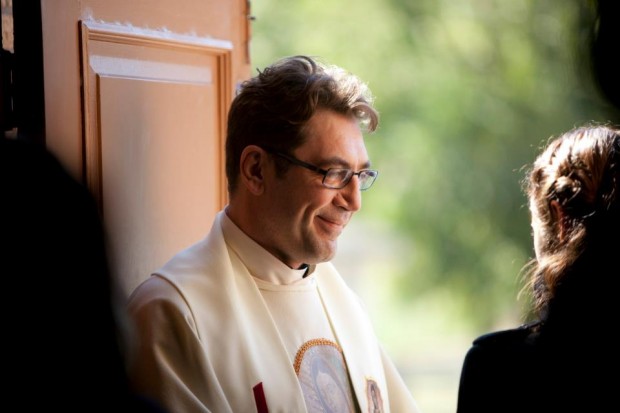
Danny K.: Like you both, I found the Bardem sequences rather jarringly disconnected, though they do inform the film with Malick’s standard interest in a man’s relationship to his religion. In that sense, while the Father Quintana character felt somewhat irrelevant to the picture’s central romance, he didn’t necessarily feel irrelevant to the picture’s overall sensibility, because he does represent ideas we’ve come to expect from Malick (especially after a work as devoutly interested in these concepts as The Tree of Life).
In response to Jordan’s comment about Malick’s capturing of the relationship’s “ups and downs,” I have to say that I found myself reacting to the romance in a curiously static way throughout the film. There were, of course, times when the Affleck–Kurylenko dynamic was depicted as a happy one: the film’s opening sequences, set in Paris, appear to paint a portrait of the relationship’s emotional peak. But even here, I was struck by the coldness we all seemed to have felt: whether the two actors were playing with Kurylenko’s daughter near a fountain, or, in a later moment, fighting in a Sonic drive-thru, the moments played out with the exact same emotional distance.
I don’t think this is a glaring fault of the film — in fact, part of what’s so haunting about it is that it has the ability to depict this life-spanning relationship in such a clinical way. But it does make me wonder if Malick’s general cinematic personality — and, in particular, the effect created in his works photographed by Emmanuel Lubezki — allows for the successful telling of a personal story. There seems to me to be something inherently cosmic about the movement of Lubezki and Malick’s camera — the way it monitors space and landscape as if it’s an organism in itself, trying to absorb every possible detail. And this aesthetic point-of-view, I think, is much more suited to the grand ambition of The New World or The Tree of Life than it is to the intimate romantic details of To the Wonder.
Jordan R.: Perhaps the “static” feeling goes towards a few additional complaints I’ve heard regarding how the film felt artificial, especially in the performances of our main quartet, and I’m curious if you felt similarly. I can’t say I completely agree, as they all seemed to fit into Malick’s meditative world, but it might attribute to the feeling of “coldness” we get and perhaps the pre-set expectations we have after viewing a film of a more conventional nature. Here, moreso than ever before in his films, Malick will use quick visual cues to represent something other directors might have spent extensive scenes dissecting. Whether it’s Kurylenko quickly storming off at a restaurant to show conflict in their marriage, or even the wandering actress and Affleck separated by floors in their own home, Malick will just spend brief moments encapsulating these peaks and valleys in a relationship.
While it’s gorgeously photographed, there is a sense that we understand all Malick is attempting to convey in perhaps the first act of the film, where we see Affleck and Kurylenko’s relationship initially flourish and disintegrate. As we progress, I became less attached to Affleck’s arc, but still completely entranced in Malick’s visual storytelling.
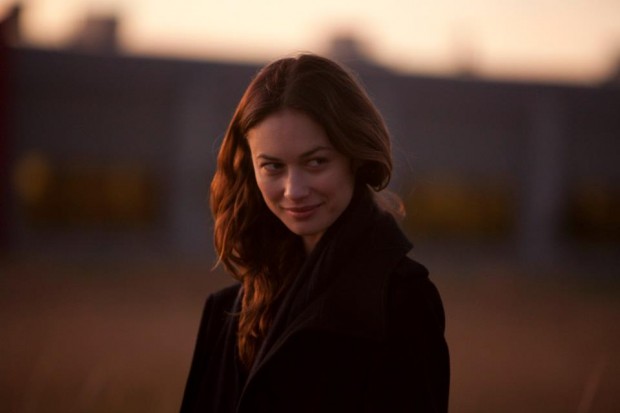
Nick N.: Danny, regarding your point about his capacity to display “personal” stories: The Tree of Life, to my mind, ceased any arguments about Malick’s ability. It’s a strongly autobiographical work that, almost contradictorily, can still tap into and work off a viewer’s life experience to tremendous, sometimes overwhelming effect. And, branching off this thought, knowing that he ran off to France following Days of Heaven — and, based on what I had once heard, because of a romantic entanglement; don’t hold me to that, however — could mark To the Wonder as, potentially, another step in this new stage of self-reflexive cinema. To that end, his romantic plunge not matching 2011’s childhood excursion are relatively acceptable — at least he’s trying something new.
Fascinating ambition does not, unfortunately, help explain why To the Wonder barely registered with true emotion or feeling. What I kept thinking as it played — more importantly, what I think has become almost solidified (or as “solidified” as this can even stand to be) in the time since — is that Malick’s now-preferred style of composition and cutting (just look no further than The Tree of Life, thou who hath not yet traveled to the Wonder) is incapable of providing portions that sustain themselves for more than, say, four minutes at a time. All of this picture’s most engrossing, resounding sequences — my mind tends to think back on Neil’s excursion with the Rachel McAdams character, Jane (another name that could only be learned via IMDb!), or his intense anger at Marina’s infidelity, capped off by the smashing of a car’s passenger-side window — wield a power in their individuality that in-the-moment glimpses of Neil and Marina, even through a felt repetition, aren’t able to establish. We do not go to the cinema of Malick to be spoonfed — we shouldn’t go to any type of cinema with that in mind, obviously — but what do I really take from multiple instances of her pretending to fall and him making a catch? What do I know about any of these people from such actions? His sense of visual storytelling remains; the story itself feels impassioned.
The New World and The Tree of Life are more akin to lengthy musical symphonies than any film I can name at the drop of a hat: pictures of multiple pieces, said pieces playing in a different key but maintaining a sense of consistency, eventually building to one thundering, rapturous crescendo that singularized everything which had come before. It would be almost too easy (and a bit hacky), then, if I were to label To the Wonder as one-note; notwithstanding the fact that I don’t think is necessarily true, one can, regardless, feel a lower register in comparison to more recent efforts. This is not a bad thing in and of itself, but, no matter how often I recognized and admired certain motifs or patterns in (those two Cs again) Malick’s composing and cutting, being an observer is about the strongest sensation an initial viewing left me with. That it does, too, feel calculated and artificial (when The Tree of Life so strongly did not) may just come down to what one type of story requires from Malick over another.
Danny K.: To circle back briefly to Jordan’s comment about the performances in the film, I was extremely taken with Olga Kurylenko throughout the picture, perhaps because her character’s wild, ever-fluctuating emotional state feels of a piece with the film’s floating-in-the-wind aesthetic.
Whereas Malick’s masculine-centered spiritual brooding worked beautifully in his previous film, which had everybody from Brad Pitt to Sean Penn to Hunter McCracken emitting a tangible essence, there seems to be far less dimension to Ben Affleck’s counterpart in To the Wonder. It says something about my muted response to the film’s romantic angle that Affleck’s most affecting scenes — the job-centered ones that had him straining to interact with the locals — can almost be seen as companion pieces (minus the frequent voice-over) to the ones centered on Javier Bardem’s neighborhood-canvassing priest. The sight of actors like Affleck and Bardem interacting with these poor, cash-strapped, tired-looking dwellers is startling in itself, and it’s a testament to Malick’s humanism that these moments never register as demeaning.
Still, though, on a first viewing, Kurylenko’s Marina most closely embodied the film’s spirit, her body always guiding the movement of Lubezki’s camera, dictating the frame. The film occasionally recalls The New World in this sense, lyrically ruminating on the energy of a female presence. Similarly, a lot of people at the time thought that Jessica Chastain’s Tree of Life performance was little more than superficial physicality, but I disagreed with them then, and, if they repeat that stance on Kurylenko, I’ll disagree with them now: like most things Malick, they’re tough to evaluate according to conventional criteria, but their unique beauty is hard to shake. Few other directors take the time and care to register an actor’s entire body as extensively as Malick: “the performers in To the Wonder are not acting; they’re dancing,” writes Bilge Ebiri in an astute interpretation of the film. But I do wonder if the two terms — acting and dancing — deserve to be separated so judiciously.
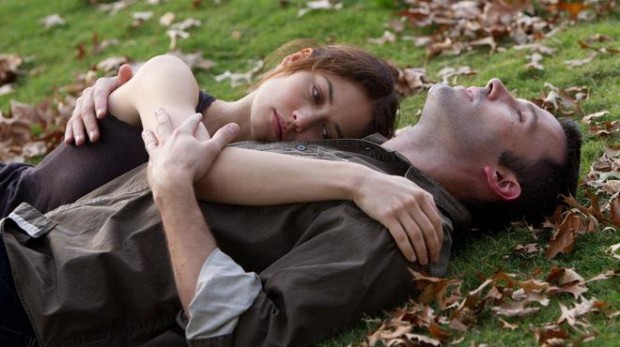
Jordan R.: Do either of you believe the modern day setting clashes with Malick’s ethereal style? While he’s captured the present day previously, most notably in Sean Penn’s storyline in The Tree of Life, this is his first film taking place entirely in the current time period and it was a bit jarring at first. Whether it be Ben Affleck‘s character at modern airports or pulling into a Sonic Drive-In or Olga Kurylenko‘s Skype session, I often did a double-take. So often he seems to be reaching towards something heavenly (having his characters to do so literally, in previous films and even here), but eventually, this setting gave way to a more grounded, relatable feel that I look forward to seeing Malick explore further in his next batch of films.
Nick N.: It was consistently galvanizing, for which I’m entirely thankful. My generally ambivalent feelings toward the greater picture notwithstanding, it was nice to see Malick in a more playful mood than efforts past, a decision which feels to stem directly from the clear awareness of alien (or alien-to-him) spaces that are being operated in. All the more rewarding is this private artist using said awareness to let fans in on unexpected level of humor, all the while unconcerned with how neophytes are going to ingest what, to them, would probably just be another piece of this strange rumination.
You say, Jordan, that this modern environment gives way for “a more grounded, relatable feel.” I’m only about halfway there with you. To my eyes, he’s synthesizing small, true-to-life details of a character’s private space — an otherwise plain piece of Jack Fisk’s production design can wordlessly capture the sort of man Neil really is (something I feel confident in saying, having known those of his stripe) — with what, to Malick, stands as a larger, stranger, now-“public” world. Whereas The Tree of Life used its Houston skyscrapers to create a heaven-like realm that merely suggests and tangentially relies upon what we perceive to be the here and now, Olga Kurylenko’s Pocahontas-like twirls through a product-laden supermarket eschew such prior convictions in the hope of finding different avenues. Malick’s formal interests may have failed him in communicating this particular story, but they suitably aide (a perceived) intent to render generally “accepted” territories an alien domain worthy of exploration — one equal to that which is afforded those elegiac wheat fields from Days of Heaven or Eden-esque tropical islands found in The Thin Red Line — and, to that end, even offer a surprising visual reconsideration of his filmography.
And, thus, it’s through the modern day that new thematic textures are found throughout: an opening of only seemingly throwaway nature — composed entirely on an iPhone, and done so to replicate his style of cinematic language — or, just as memorably, the winking-from-behind-a-camera transitional line “have a Super Sonic evening” earn their consideration and / or genuine laughs because he’s facing us, (figuratively) naked, simply asking for as much. That Malick knows what a fan expects and, often, decides to elegantly undercut it — i.e., unless he isn’t aware of the effect an otherwise simple bit of dialogue would have on his observant admirers, but I refuse to accept that notion — was the most rewarding thing To the Wonder was capable of providing.
Thinking and typing about all this over the course of a few weeks, it finally occurs to me that I was (possibly) too rough in starting out. To the Wonder still strikes yours truly as a failed standalone story, never finding a beating heart to make its slippery dramatic center at all affecting; taken as “part six” of Terrence Malick’s oeuvre, however, it’s a potent avenue to highlighting and reframing what we had assumed was already more or less figured out. Despite all I’ve said, a revisit is in order.
Danny K: Without going into too much rehashing — because Nick does leave things on a nice closing note here — I’ll simply reiterate the idea that, for all the uncertainty and inconsistency with which I felt To the Wonder operated, it’s a film I’ll certainly see again when it hits theaters, and I’m sure I’ll be tempted to continue writing about it in the time afterwards. Unlike with previous first-time viewings of Malick films, where I came out convinced that I had seen an unreservedly great piece of work, I had a lot of questions after To the Wonder ended, but the mere existence of those questions shouldn’t imply negativity. Rather, as I’ve argued, they imply a bit of step sideways for Malick more than anything else — they’re signposts signaling a new path in his career, one defined by different narrative ambitions.
Jordan R.: Closing out the conversation, like any other Malick film, I’m eager to revisit To the Wonder as well. Whereas a return to his other works have been spurred by the desire to simply live in their respective worlds again, his latest is the one I’ve wrestled with the most since viewing and I look forward to seeing if any qualms regress or grow stronger, especially after this discussion. Regardless, it’s a film I would highly recommend and while one may have easier access finding it on VOD, this should go without being said, but I urge you to hold out until a theatrical viewing, if such an experience is within your reach.

To the Wonder arrives on VOD and in limited release on Friday, April 12th.
What did you like of Malick’s latest? Continue the conversation below in the comments.

